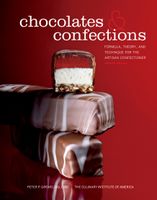Advertisement
Metal Molds
Appears in
By Peter Greweling and Culinary Institute of America
Published 2007
For many years chocolate molds were all made of steel and lined with a thin coating of tin to protect them from rust and to provide a shiny surface for molding. These molds are not commonly made or used now; they have been replaced by lighter, less expensive plastics. Metal molds, including antique molds, can still be used to produce excellent-quality products, provided the interior of the mold is in good condition. When evaluating metal molds for use, look closely at the interior surface, inspecting it for scratches, dents, rust, pits, and cracks. Chocolate makes a mirror image of the surface it sets on. If the interior of the mold is shiny and smooth, the chocolate that comes out of it will also be shiny and smooth. If the interior of the mold is pitted, dull, or scratched, the chocolate that comes from it will also have a poor appearance. Metal molds have accrued value as collectibles, so their cost is inflated as compared to modern plastic alternatives. For production purposes, metal molds are not usually worth the price.



